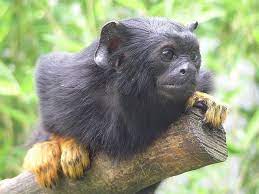The red-handed tamarin, scientifically known as Saguinus midas, is a captivating creature that inhabits the dense rainforests of South America. With its striking appearance and social behaviors, this small primate has captured the attention of researchers and nature enthusiasts alike. Join us as we delve into 17 intriguing facts about the red-handed tamarin, shedding light on its unique traits and its significance within its rainforest ecosystem.

1. Vivid Markings: The red-handed tamarin gets its name from its distinctive red-orange fur on its feet and hands, creating a stunning contrast with its black body.
2. Miniature Marvels: These tiny primates have a compact body size, with adults weighing around 400 to 550 grams.
3. Family Dynamics: Red-handed tamarins live in tight-knit family groups, which consist of a dominant breeding pair and their offspring.
4. Vocal Communication: These tamarins communicate through a wide range of vocalizations, from sharp calls to soft trills.
5. Insectivorous Diet: Their diet primarily consists of insects, spiders, and small vertebrates, supplemented by fruits and nectar.
6. Omnivorous Behaviors: Red-handed tamarins have been observed occasionally consuming eggs and small vertebrates, showcasing their opportunistic feeding habits.
7. Reproductive Roles: Within their family groups, only the dominant female gives birth, while other females may assist in caring for and carrying the young.
8. Twin Births: Twin births are common for red-handed tamarins, and all members of the group help care for the newborns.
9. Fatherly Love: Male tamarins play an active role in caring for the young, often carrying and protecting them.
10. Social Grooming: Grooming is an essential social behavior that helps strengthen bonds within the group.
11. Habitat and Range: These primates are found in the Amazon rainforests of South America, including parts of Brazil and Peru.
12. Canopy Dwellers: Red-handed tamarins are skilled climbers, spending most of their time in the trees of the rainforest canopy.
13. Prehensile Tail: Their long, prehensile tails help them maintain balance while navigating through the treetops.
14. Seed Dispersers: As they consume fruits and nectar, red-handed tamarins play a role in seed dispersal within their habitat.
15. Threats and Conservation: Habitat loss and the pet trade are significant threats to their populations. Conservation efforts focus on preserving their rainforest homes.
16. Complex Societies: Research has revealed that red-handed tamarins exhibit complex social behaviors, including alliances and cooperative behaviors.
17. Ecological Importance: These primates contribute to rainforest health by controlling insect populations and aiding in pollination.
Conclusion
The red-handed tamarin, with its vibrant appearance and intricate social behaviors, showcases the marvels of rainforest life. As we explore these 17 fascinating insights, we gain a deeper appreciation for the role these remarkable primates play in maintaining the balance of their delicate ecosystem.



















Add Comment